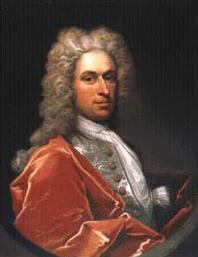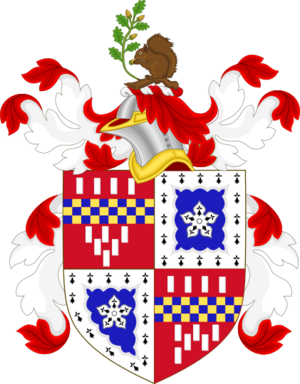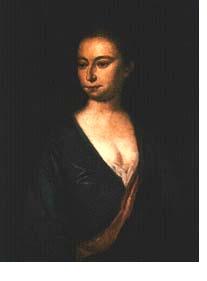Thomas Lee (Virginia colonist) facts for kids
Quick facts for kids
Thomas Lee
|
|
|---|---|
 |
|
| House of Burgesses | |
| In office 1723–1733 Serving with George Eskridge
|
|
| Preceded by | Daniel McCarty |
| Succeeded by | Daniel McCarty Jr. |
| Council of State of Virginia | |
| In office 1733–1750 |
|
| Royal Governor of Virginia | |
| In office 1749–1750 |
|
| Preceded by | William Gooch |
| Succeeded by | Robert Dinwiddie |
| Personal details | |
| Born | c. 1690 Mount Pleasant at Machodoc River, Westmoreland County, Colony of Virginia |
| Died | November 14, 1750 (aged 59-60) Stratford Hall, Westmoreland County, Colony of Virginia |
| Spouse | Hannah Harrison Ludwell |
| Children | Philip Ludwell Lee, Richard Henry Lee, Thomas Ludwell Lee, Francis Lightfoot Lee, William and Arthur Lee |
| Parents | Richard Lee II Laetitia Corbin |
| Residences | Machodoc River, later Stratford Hall Plantation |
| Alma mater | The College of William and Mary |
Thomas Lee (around 1690–November 14, 1750) was an important person in colonial Virginia. He was a planter, which means he owned and managed large farms where crops like tobacco were grown. He was also a politician, helping to make laws and govern the colony.
Thomas Lee was part of the famous Lee family. This family was a powerful political dynasty, meaning many of its members were involved in government and public life for a very long time. Lee started his political journey in 1710. He managed a large area of land called the Northern Neck Proprietary for Lady Catherine Fairfax. After his father passed away, Thomas inherited land and later bought even more. These lands became big plantations for growing tobacco.
In 1722, Thomas Lee married Hannah Harrison Ludwell. This marriage helped him connect with the well-known Harrison family of Virginia. A year later, he became a member of the House of Burgesses, which was like a colonial parliament. After his home was destroyed by a fire, he built a new one called Stratford Hall on the Potomac River. In 1733, he joined the Virginia Governor's Council, a higher group of lawmakers. He also helped start the Ohio Company of Virginia in 1747. This company aimed to expand Virginia's land into the Ohio River Valley. For a short time in 1749, he even served as the acting royal governor of Virginia. Thomas Lee was a strong candidate to become the official governor, but he passed away in 1750.
Contents
Thomas Lee's Early Life and Schooling
Thomas Lee was born around 1690 at a place called Mount Pleasant in Westmoreland County, Virginia. His parents were Richard Lee II, who was known as "the scholar," and Laetitia Corbin. His family had moved to Virginia from England in 1642. Thomas was the fourth son, so he didn't inherit as much land as his older brothers. However, this didn't stop him from becoming very successful in politics.
Around 1700, Thomas Lee went to The College of William and Mary. His education was described as a "common Virginia education." He soon became very interested in the tobacco industry. He left home to work with his uncle, Thomas Corbin, learning about the tobacco business.
Thomas Lee's political career began in 1710. He was given the job of Naval Officer of the Potomac River. This job involved collecting customs, which were taxes on goods coming into the colony by ship. His father used to have this job, and Thomas took over when his father stepped down.
In 1711, his uncle Thomas Corbin helped him get another important job. He became the Virginia agent for the Northern Neck Proprietary. This meant he managed a huge area of land, about six million acres, between the Potomac and Rappahannock rivers. This land belonged to Lady Catherine Fairfax, who lived in England. Thomas Lee held this position until 1722. In 1713, he also took over his father's role as Naval Officer for the south side of the Potomac.
When his father died in 1714, Thomas inherited land in Northumberland County and Maryland. He also leased his family's old estate, "Machodoc," from his brother who lived in London. That same year, Thomas visited England for about a year. While there, he decided to buy a property on the Potomac River called the "Clifts Plantation." He believed that one day, the capital of Virginia might be located on the Potomac. He later renamed this property Stratford.
In 1720, Thomas Lee tried to become a Burgess for Westmoreland County. A Burgess was a representative in the colonial assembly. He won the election in 1728. However, in 1733, he was appointed to the Governor's Council, which was the upper house of the legislature. He then gave up his Burgess seat.
Marriage and Family Life
Thomas Lee believed that marriage was important not just for two people, but for their families too. He thought it could help families become stronger and wealthier. In May 1722, Thomas Lee married Hannah Harrison Ludwell. Hannah was from the very important Harrison family of Virginia. Their marriage brought him more wealth and higher social standing.
Thomas and Hannah had eleven children, and eight of them lived to adulthood:
- Philip Ludwell Lee (1726–1775)
- John Lee (1728–1782)
- Hannah Lee Corbin (1729–1782)
- Thomas Ludwell Lee (1730–1778); he helped write the Virginia Declaration of Rights.
- Richard Henry Lee (1732–1794); he was a signer of the United States Declaration of Independence.
- Francis Lightfoot Lee (1734–1797); he also signed the United States Declaration of Independence.
- William Lee (1737–1795)
- Arthur Lee (1740–1792)
In 1728, a terrible event happened to the Lee family. Thieves broke into their home at Machodoc. They stole valuable items and then set the house on fire. The fire destroyed almost everything, including Thomas's office and all their possessions. Hannah Lee, who was pregnant, had to be helped from a second-floor window. This caused her to lose her baby. A young enslaved girl was also hurt and died from her injuries.
The governor of Virginia, William Gooch, said that criminals were to blame. Thomas Lee lost a lot of money in the fire. British officials and even Queen Caroline gave him money to help rebuild. The criminals were found guilty, but their punishment is not known. After the fire, the family stayed with Thomas's brother Henry while their new mansion, Stratford Hall, was being built.
Thomas Lee's political work meant he often had to travel to Williamsburg. This kept him away from his family for long periods. However, he always tried to be with his wife for the birth of each of their children. Many of his sons became important political figures. They were active during the American Revolutionary War and in politics afterward. For example, Richard Henry Lee became a senator, and Francis Lightfoot Lee was in the Virginia Senate. His youngest sons, William and Arthur, served as diplomats in Europe.
Thomas Lee also became a vestryman for Cople Parish, which was a church leader. He was also a Justice of the Peace in Westmoreland County. In 1723, he became a member of the House of Burgesses. He held this job until 1733 when he was appointed to the Virginia Governor's Council. This was a lifetime position. The Council had twelve members chosen by the Governor. They advised the governor and served as judges. This role also gave Thomas Lee the military rank of Colonel.
When Governor William Gooch returned to England in 1749, Thomas Lee was named President of the King's Council of Virginia. He also became the Commander-in-Chief of the colony. King George II wanted to appoint him as the official Governor of Virginia, but Thomas Lee died before this could happen.
The Ohio Company
In 1744, Thomas Lee was chosen to negotiate with the Six Nations of the Iroquois at the Treaty of Lancaster. At this meeting, an agreement was made. The Six Nations allowed Virginians to travel through and settle in the Shenandoah Valley in exchange for money.
In 1747, Thomas Lee helped start the Ohio Company of Virginia. Other important people like Lawrence Washington were also involved. The Ohio Company was a business that bought and sold land. It helped to settle the Ohio Country. Thomas Lee's position on the Governor's Council helped the company succeed. Within seven years, 100 families were living in Ohio because of the company. Thomas Lee was the first president of the Ohio Company. After he died, Lawrence Washington took over.
Building Stratford Hall
As Thomas Lee became more important and wealthy, he decided he needed to build a grand mansion. This would show his high standing as one of Virginia's gentry, which were wealthy and influential families. He chose a place called "the Clifts" for his new home. He had owned this land since the 1710s. He picked this spot because it was in his home county of Westmoreland and was located right on the Potomac River.
The exact year construction began on Stratford Hall is not known, but it was likely between 1725 and 1730. All of Thomas Lee's sons were born at Stratford. Many different types of workers helped build the plantation. There were free people, indentured servants (who worked for a set time to pay off their travel to America), and African slaves.
Between 1719 and 1746, Thomas Lee bought many large areas of land. These lands are now in Arlington, Fairfax, Fauquier, Prince William, and Loudoun counties. The town of Leesburg was named in his honor. This was suggested by his two sons, who helped found the town.
Hannah Harrison Lee passed away at Stratford Hall on January 25, 1749. She had given birth to eleven children. She was buried in the old family burial ground at Mount Pleasant. Thomas Lee died on November 14, 1750, at the age of sixty. He was buried next to his wife and mother, as he wished in his will. He left Stratford Hall to his oldest son, Philip Ludwell Lee.
|




